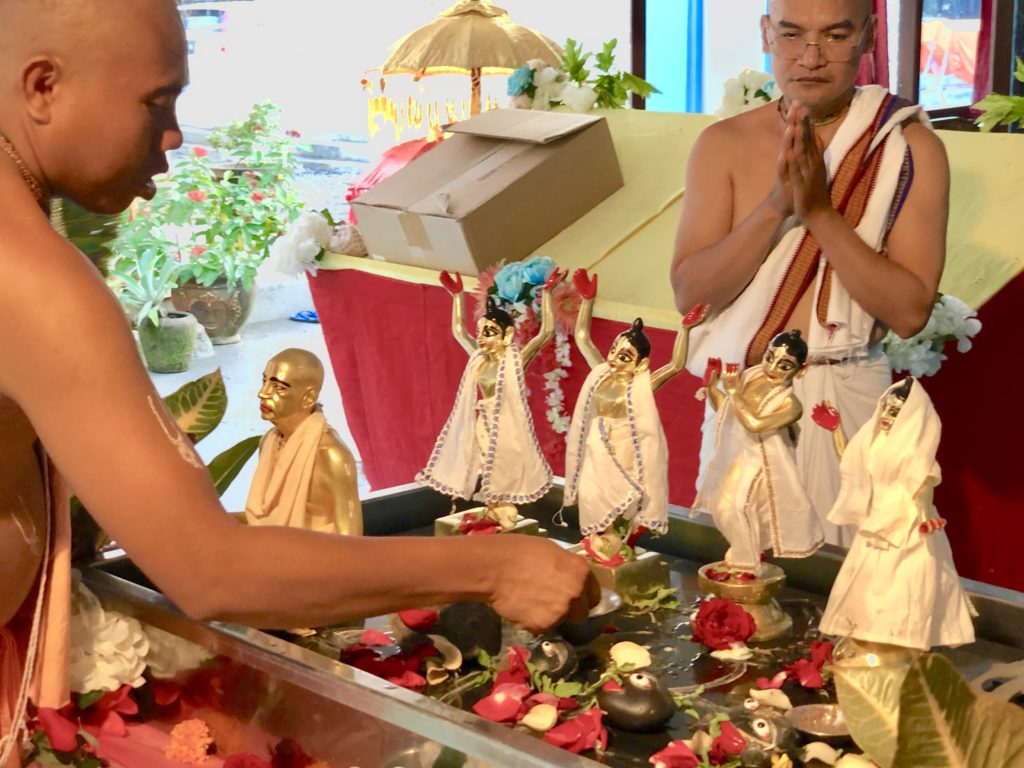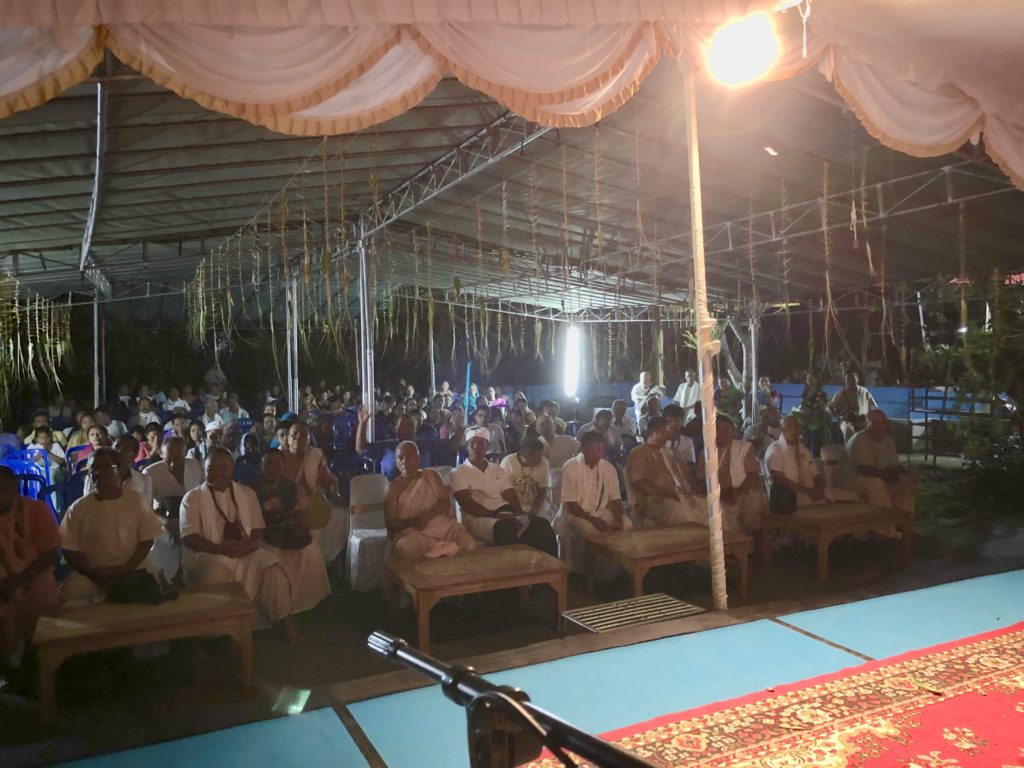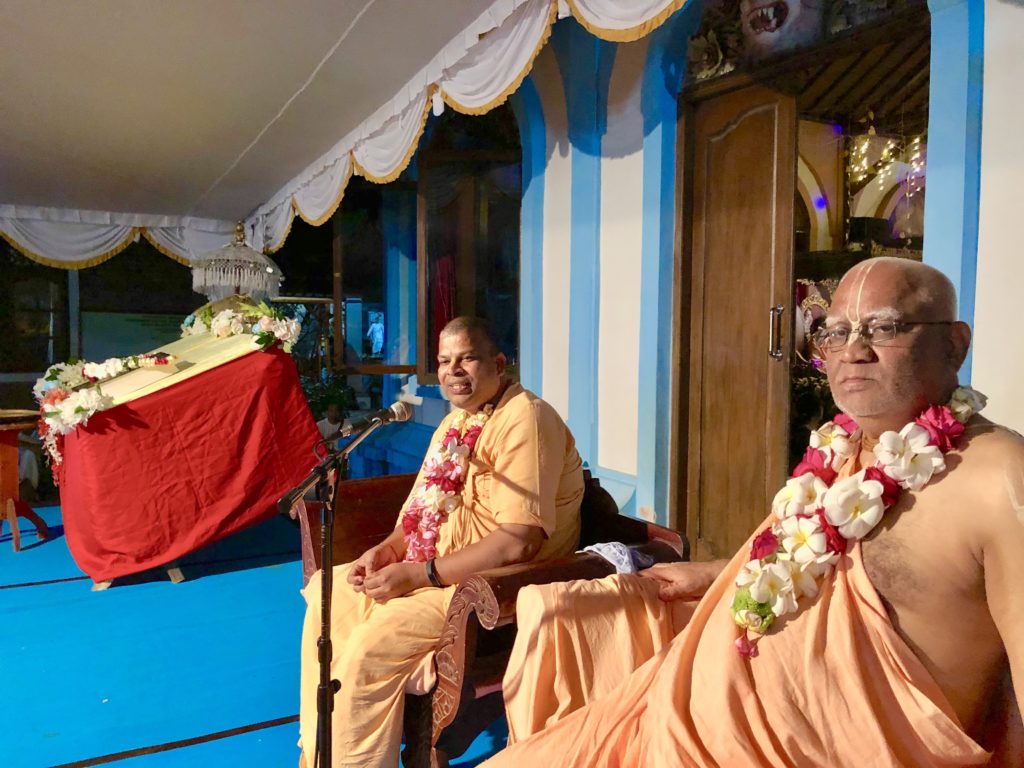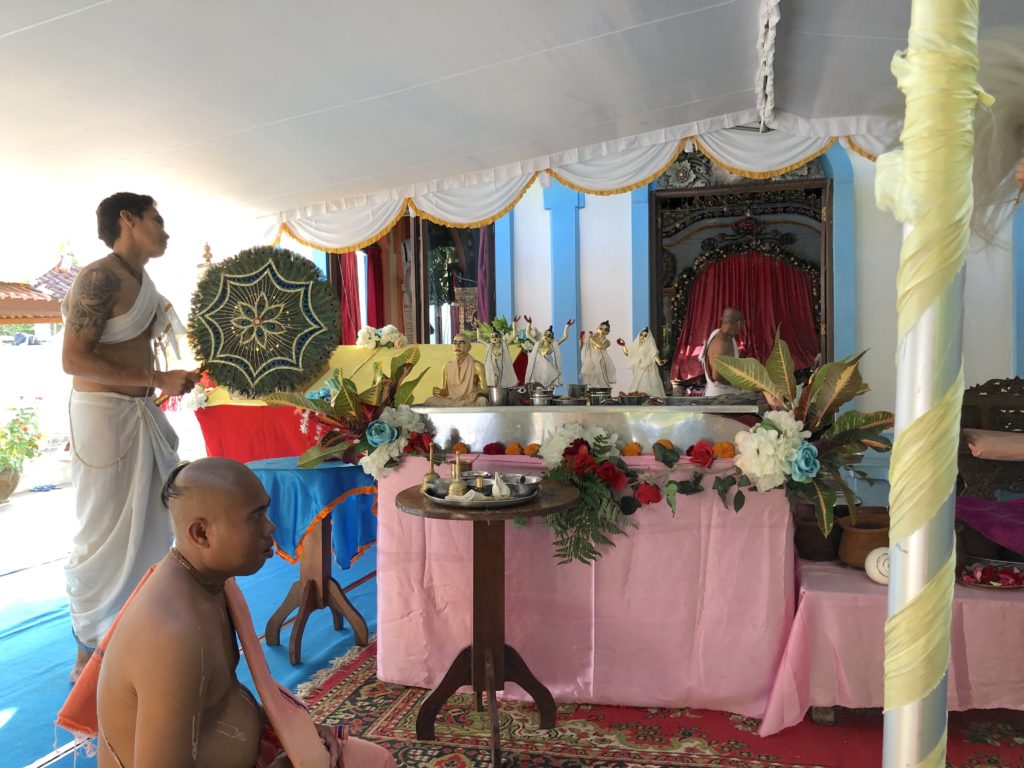
A video by ISKCON Desire Tree.
Websites from the ISKCON Universe

In ISKCON today, we typically call everyone who joined the movement “the first generation.” We call all the children of those who joined “second generation,” no matter their age, and all their children “third generation.” But now the gurukuli pioneers have come forward to say that continuing to use the term to describe everyone across a thirty-year timespan is confusing and problematic.

Join in, Gain the magic and Share with others (19 min video)
Sutapa Das: We have knocked 10,000 doors now! That is record-brea...

Unparallel enthusiasm and dancing in Durban, South Africa (2 min video)
Srila Prabhupada: The Krishna consciousness movement s...

Preaching program at the beautiful Iskcon Temple in Raffray, Mauritius (Album of photos)
Bhakti Chaitanya Swami: Last night we...
 ISKCON presents a cutting edge conference on health care- 15 category 1 CME credits to be awarded to the attendees East Meets West: A holistic approach to health.
ISKCON presents a cutting edge conference on health care- 15 category 1 CME credits to be awarded to the attendees East Meets West: A holistic approach to health.  By Jaya Gaursundar Dasa
By Jaya Gaursundar Dasa Krishna maintains as well as fulfills the desires of enumerable materially engrossed jivas. Because He is responsible; He maintains all living entities, although He does it through His expansions and energies. However Kṛṣṇa Himself personally attends to relatively small group of souls who are interested in His direct love and protection. He exemplifies this tender concern toward His faltering bhaktas. That is His real nature to reciprocate with His devotees. Continue reading "Bhakta-vatsalya of Sri Krishna
→ Dandavats"

Prasadam distribution in HelenvalePort Elizabeth, South Africa (Album of photos)
Dear Devotees. Please accept my humble obeisa...

Srila Prabhupada’s mission is reaching out to everyone!
I stopped stunning 85-year-old Noreen today. She loved what I was doing and said she has an altar at home and a beautiful relationship with God. As I told her about the Veda she eagerly took one saying she would love to read it and deepen her relationship with God. How fortunate is this 85-year old coming into contact with Krishna. It really is never too late. Srila Prabhupada’s mission is reaching out to everyone and the book marathon is making it happen!

Truly uplifting!
Meet Jim (left) and John (right). Yesterday, in Coventry, UK, as I was speaking to someone, John came over and started to look at the Veda on top of my trolley. As I finished speaking to the person, I approached John and he asked me what the books were about. I had quite literally only just started to brief him, and in an instant, he took a note out of his wallet and placed it in my hand and walked off with the book. I was amazed, intrigued and curious. This is one of the many magical experiences we encounter on the streets. I recalled this exchange a number of times in the day thinking how rewarding book distribution is. To my surprise, John came to see me again this morning with his friend Jim. He asked for another Veda. He then explained to me that he had taken the book home and his wife and son were arguing over the book, both wanting to be the first to read it. His wife started to read it and became instantly immersed so his son said he would download the e-book, however John insisted that he would buy him another book the following day. John also decided to take the Bhagavad Gita to read so they could all read a book each together as a family. Jim was standing listening to us and he became so intrigued about the books, clearly the conversation had a galvanizing effect on him, that he also took one of each. These encounters truly pierce my soul knowing that people are not only taking Srila Prabhupada’s books but they are reading and sharing them, and buying more for family and friends. Truly uplifting.
Answer Podcast
The post Why did the Dwarka Yadus kill each other? appeared first on The Spiritual Scientist.


Sri Sri Radha Rasesvara temple was opened 19 years ago just outside Denpasar, Bali. Since then the community of devotees has grown extensively with many purchasing houses in the area.
Atmanivedana Swami, Bhakti Jivan Maharaja and I were invited for the anniversary celebration. The afternoon started with abhiseka of the deities, then speeches, dance performances, arati and feast.


 Today is Odana-sasthi, the date on which Lord Jagannatha is given a winter shawl. One year, when Lord Caitanya and His associates celebrated this festival in Puri, Purdarika Vidyanidhi, who is Vrsabhanu Maharaja, Srimati Radharani’s father, in krsna-lila, received some special mercy. His experience is instructive for us all.
Today is Odana-sasthi, the date on which Lord Jagannatha is given a winter shawl. One year, when Lord Caitanya and His associates celebrated this festival in Puri, Purdarika Vidyanidhi, who is Vrsabhanu Maharaja, Srimati Radharani’s father, in krsna-lila, received some special mercy. His experience is instructive for us all.
Srila Prabhupada explains, “At the beginning of winter, there is a ceremony known as the Odana-sasthi. This ceremony indicates that from that day forward, a winter covering should be given to Lord Jagannatha. That covering is directly purchased from a weaver. According to the arcana-marga, a cloth should first be washed to remove all the starch, and then it can be used to cover the Lord. Pundarika Vidyanidhi saw that the priest neglected to wash the cloth before covering Lord Jagannatha. Since he wanted to find some fault in the devotees, he became indignant.” (Cc Madhya 16.78 purport)
And Sri Caitanya-caritamrta (Madhya 16.78-81) describes the event: “Pundarika Vidyanidhi initiated Gadadhara Pandita for the second time, and on the day of Odana-sasthi Pundarika Vidyanidhi saw the festival. When Pundarika Vidyanidhi saw that Lord Jagannatha was given a starched garment, he became a little hateful. In this way his mind was polluted. That night the brothers Lord Jagannatha and Balarama came to Pundarika Vidyanidhi and, smiling, began to slap him. Although his cheeks were swollen from the slapping, Pundarika Vidyanidhi was very happy within. This incident has been elaborately described by Thakura Vrndavana dasa.”
From this incident, we can learn that the Lord does not tolerate offenses against His servants, even from an advanced devotee, and that He chastises a devotee who commits such an offense even within the mind. We can also learn that a pure devotee accepts such chastisement from the Lord with great happiness, as a manifestation of the Lord’s mercy, of His love and care for His devotees—both for those who may commit such an offense and for those who may be objects of such an offense. He thanks the Lord for rectifying him and preventing him from committing further offenses, and he feel great jubilation within his heart.
Hare Krishna.
Yours in service,
Giriraj Swami

Gaur Gopal Das: It was a great pleasure and honor meeting and discussing with Arianna Huffington (@AriannaHuffington).
Grateful for your book ‘The Sleep Revolution.’
My sincere best wishes and support for the great work that you are doing.

Closing Ceremony: Govardhana Retreat 2018 (Album of photos)
Srila Prabhupada: “Oh Govinda! Feeling Your separation, I am considering a moment to be like twelve years or more. Tears are flowing from My eyes like torrents of rain, and I am feeling all vacant in the world in your absence.” This is the perfectional stage of chanting the Hare Krishna mantra. (Caitanya-caritamrta, Adi-lila, 8.51 Purport)
Find them here: https://goo.gl/76a1nX

The significance of Odana Sasthi, December 3 (audio mp3)
At the beginning of winter, there is a ceremony known as the Odana Sa...

ISKCON Nepal Annual Yatra (Album of photos)
This Year ISKCON Nepal Annual Yatra trip was to South India with HG Patri Prabhu.<...

Kolkata to Sri Dhama Mayapur and back by smooth ferry boat.
Srila Prabhupada goes out on the Maidan Cruise of the fiberglass twin-engine catamaran marine craft called the Jala - Duta 1 (3 min video)
The Company Name on the side of the marine craft is the “Mayapur Ganga Vivada Cruise Services. This ferry boat will carry passengers in quiet, smooth air-conditioned comfort like experienced on International airline flights. The craft is equipped with forty-two airline reclining seating and will bring the passenger in safe relaxing comfort from Kolkata to Sri Dhama Mayapur and back. What a nice way to travel to the Holy Dhama on the Sacred River Ganges.
 By Govinda Dasi
By Govinda Dasi For me, the reason I like to hear other devotees’ memoirs and experiences, such as in Siddhanta Prabhu’s “Memories” series, and Yadubar/Visakha’s “Following Srila Prabhupada” series, and even simple memories on Facebook, is that when I came to be with Srila Prabhupada, it was at a very different time. I love to hear what other devotees experienced. I love to hear their realizations. And I see the common thread of awe and inspiration at the time of their first meeting with Srila Prabhupada. And I think it is important for everyone who was there at that magical time to share their experiences and realizations of what it was like to be in the presence of a “modern-day saint.” Continue reading "The Iskcon Hare Krishna Explosion From The Inside
→ Dandavats"
 By Shyamananda Dasa
By Shyamananda Dasa ISKCON devotees started the procession with a unique traditional bullock cart with hundreds of Vaisnava sadhus following the cart of Nitai Gaura Sundar and Srila Prabhupada, and blessed millions of pilgrims and devotees by their melodious kirtan. This Padyatra bullock cart has been travelling all over India for last 29 years since it started in 1984. The ISKCON Camp at Maha Kumbha Mela was located on Tulasi Marg, sector 5, Mori Gate (under Taragunj Railway bridge), and accommodated nearly 1,000 devotees from all over the world. The dioramas depicting churning Kshira Sagar by demigods and demons, the Gajendra-moksha-lila, Ram-Lila with monkeys attracted a lot of visitors.This tradition has been carried on till this day. Continue reading "Kumbha Mela – A symbol of co-operation for greater cause
→ Dandavats"
 By Jaganmohini Devi Dasi
By Jaganmohini Devi Dasi As a founder director of Bhaktivedanta Institute, HH Bhaktisvarupa Damodara Swami, was able to lay the foundation of the Bhaktivedanta Institute under Srila Prabhupada's direct guidance. During Srila Prabhupada's final days and even before that HH Bhaktisvarupa Damodara Swami was very enthusiastic and had adopted versatile and dynamic approach to reach to intellectual community. And Srila Prabhupada very much approved and appreciated it. There are several conversations between them in this regard. Thereafter, for nearly three decades, HH Bhaktisvarupa Damodara Swami has made pioneering efforts to provide a platform for mutual dialogue among scientists, religious leaders and academicians, such that both the scientists and spiritual leaders would have the opportunity to learn from each other and thereby broaden their respective world views for the benefit of mankind Continue reading "Bridging Science and Spirituality
→ Dandavats"

Jagannath Rath Yatra in Baudda, Nepal (Album of photos)
Srila Prabhupada: “As a result of chanting the Hare Krishna maha-mantra, one makes such great advancement in spiritual life that simultaneously his material existence terminates and he receives love of Godhead. The holy name of Krishna is so powerful that by chanting even one name, one very easily achieves these transcendental riches.” (Caitanya-caritamrta, Adi-lila, 8.28)
Find them here: https://goo.gl/vAUBeW

Book distribution and Harinama in Paris (Album of photos)
Srila Prabhupada: Krishna is the root of everything. IF He is please...
Answer Podcast
The post While struggling with conditionings how can we avoid the extremes of becoming hopeless and becoming shameless? appeared first on The Spiritual Scientist.

ISKCON Philadelphia: New Temple: 12-8-18 (Album of photos)
Srila Prabhupada: People should be given the chance to hear the ch...

Fixing the mind on Krishna (video)
Srimad Bhagavatam Class by HH Radhanath Swami on| 9th Dec 2018 at ISKCON Chowpatty, Mumbai

Inspirational life journey as an ISKCON Devotee of Ananda Krishna Devi Dasi (12 min video)
Ultimate inspiring journey any pers...
 This movement offers the opportunity, the eagerness required to become a pure devotee. We have the opportunity of beginning the day with an offering to the Lord. No day is ordinary, everyday is special. Different days are linked to different planets. All that matters is what we really want to do. Come to that stage of pure devotional service.
This movement offers the opportunity, the eagerness required to become a pure devotee. We have the opportunity of beginning the day with an offering to the Lord. No day is ordinary, everyday is special. Different days are linked to different planets. All that matters is what we really want to do. Come to that stage of pure devotional service.